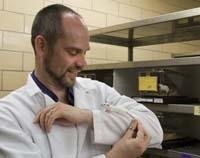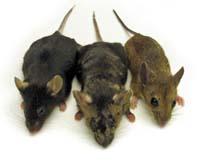So many mice are not needed
2009/05/02 Galarraga Aiestaran, Ana - Elhuyar Zientzia
It is common to use mice to test medications and treatments for people. In these experiments, all the parameters are very measured, so that if someone does the same experiment they have the same results. This is one of the characteristics of the scientific method, that is, the experiments must be repeatable.

rJoseph Garner of Purdue University believes that it is counterproductive to control experimental mice and the environment so narrowly and rigorously.
Photo: Purdue University)
To ensure that the experiment is repeatable, researchers control as much detail as possible, such as mice and related parameters. Thus, researchers select mice identical to genetics and in the research report they clearly indicate their type. The same is done with factors that can influence the mouse: cage size, room temperature, diet...
Joseph Garner of Purdue University believes it is useless to want to control all factors. Mice respond to stimuli that people don't even detect. Garner provides an example: in a lab, the smell of a researcher can cause stress in a mouse, and in another lab, that of another researcher may not affect another mouse. According to this, the same research can give different results in one laboratory or another, and as researchers do not know what the reason has been, they can make a wrong interpretation.
In addition, when drugs and substances are tested on people, volunteers participating in the tests are not the same. And it would also not be convenient, if you then want this medicine to be useful for many people. So why control experimental mice and their environment so rigorously?
Test tests
To check the influence of the factors present in a supposedly controlled environment, Garner performed the same experiment with three mouse types, two cages and three different times. So, he did the same experiment in 18 ways. And it obtained different results, but not as expected, that is, they did not depend on the type of mouse or cage, but on other factors not considered.
When this happens, for example, when an experiment is repeated to test a drug and the result is not the same as the previous one, many more tests are done, that is, many more mice are used. And that is harmful, not only for mice, but also economically.
According to Garner, drugs are expensive, especially because pharmaceutical companies invest a lot of money in creating them. In fact, for every drug on the market there are about a hundred left on the road at any stage of clinical trials. Therefore, they recover the money they have lost with them through medications they say goodbye.
Therefore, Garner has come to the conclusion that it is better that in experiments mice are in very varied environments, which allows to obtain more useful results than otherwise, or that when interpreting errors are made less and also less mice are needed. According to Garner, "it would benefit pharmaceutical research, patients and mice."
Knowing the number of mice used in research, Garner's reflection is interesting: 30 million mice a year are used in laboratories around the world.
Published in Gara

Gai honi buruzko eduki gehiago
Elhuyarrek garatutako teknologia






